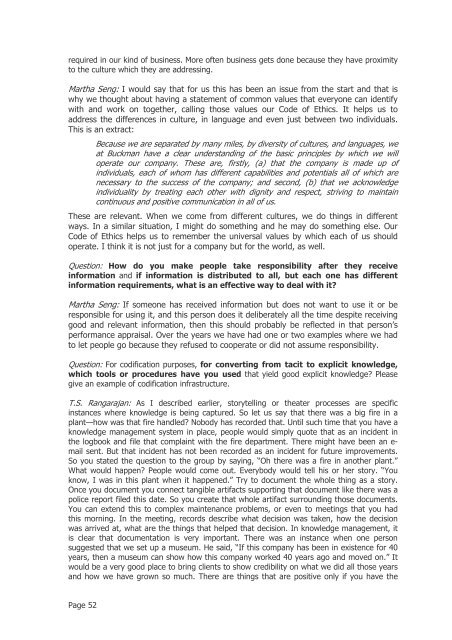Knowledge Management: From Brain to Business (PDF 5.5 - Asian ...
Knowledge Management: From Brain to Business (PDF 5.5 - Asian ...
Knowledge Management: From Brain to Business (PDF 5.5 - Asian ...
Create successful ePaper yourself
Turn your PDF publications into a flip-book with our unique Google optimized e-Paper software.
equired in our kind of business. More often business gets done because they have proximity<br />
<strong>to</strong> the culture which they are addressing.<br />
Martha Seng: I would say that for us this has been an issue from the start and that is<br />
why we thought about having a statement of common values that everyone can identify<br />
with and work on <strong>to</strong>gether, calling those values our Code of Ethics. It helps us <strong>to</strong><br />
address the differences in culture, in language and even just between two individuals.<br />
This is an extract:<br />
Page 52<br />
Because we are separated by many miles, by diversity of cultures, and languages, we<br />
at Buckman have a clear understanding of the basic principles by which we will<br />
operate our company. These are, firstly, (a) that the company is made up of<br />
individuals, each of whom has different capabilities and potentials all of which are<br />
necessary <strong>to</strong> the success of the company; and second, (b) that we acknowledge<br />
individuality by treating each other with dignity and respect, striving <strong>to</strong> maintain<br />
continuous and positive communication in all of us.<br />
These are relevant. When we come from different cultures, we do things in different<br />
ways. In a similar situation, I might do something and he may do something else. Our<br />
Code of Ethics helps us <strong>to</strong> remember the universal values by which each of us should<br />
operate. I think it is not just for a company but for the world, as well.<br />
Question: How do you make people take responsibility after they receive<br />
information and if information is distributed <strong>to</strong> all, but each one has different<br />
information requirements, what is an effective way <strong>to</strong> deal with it?<br />
Martha Seng: If someone has received information but does not want <strong>to</strong> use it or be<br />
responsible for using it, and this person does it deliberately all the time despite receiving<br />
good and relevant information, then this should probably be reflected in that person’s<br />
performance appraisal. Over the years we have had one or two examples where we had<br />
<strong>to</strong> let people go because they refused <strong>to</strong> cooperate or did not assume responsibility.<br />
Question: For codification purposes, for converting from tacit <strong>to</strong> explicit knowledge,<br />
which <strong>to</strong>ols or procedures have you used that yield good explicit knowledge? Please<br />
give an example of codification infrastructure.<br />
T.S. Rangarajan: As I described earlier, s<strong>to</strong>rytelling or theater processes are specific<br />
instances where knowledge is being captured. So let us say that there was a big fire in a<br />
plant—how was that fire handled? Nobody has recorded that. Until such time that you have a<br />
knowledge management system in place, people would simply quote that as an incident in<br />
the logbook and file that complaint with the fire department. There might have been an email<br />
sent. But that incident has not been recorded as an incident for future improvements.<br />
So you stated the question <strong>to</strong> the group by saying, “Oh there was a fire in another plant.”<br />
What would happen? People would come out. Everybody would tell his or her s<strong>to</strong>ry. “You<br />
know, I was in this plant when it happened.” Try <strong>to</strong> document the whole thing as a s<strong>to</strong>ry.<br />
Once you document you connect tangible artifacts supporting that document like there was a<br />
police report filed this date. So you create that whole artifact surrounding those documents.<br />
You can extend this <strong>to</strong> complex maintenance problems, or even <strong>to</strong> meetings that you had<br />
this morning. In the meeting, records describe what decision was taken, how the decision<br />
was arrived at, what are the things that helped that decision. In knowledge management, it<br />
is clear that documentation is very important. There was an instance when one person<br />
suggested that we set up a museum. He said, “If this company has been in existence for 40<br />
years, then a museum can show how this company worked 40 years ago and moved on.” It<br />
would be a very good place <strong>to</strong> bring clients <strong>to</strong> show credibility on what we did all those years<br />
and how we have grown so much. There are things that are positive only if you have the
















